Family name: Thismiaceae J. Agardh
Synonym(s): [none]
Common name(s): thismia family
*Number of genera/species: 5/77
List of genera records in GRIN-Global
seed
Fruit a circumscissilecircumscissile:
(~pyxis); type of capsular dehiscence, opens by a lid (splitting transversely)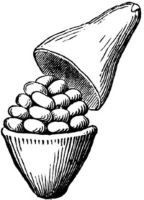 capsulecapsule:
capsulecapsule:
a dry, dehiscent fruit derived from a compound ovary , hemisphericalhemispherical:
, hemisphericalhemispherical:
2D shape—shaped like half a sphere
or conicalconical:
3D shape—cone-shaped, with the point of attachment at the broad end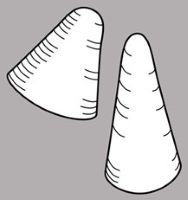 , 1.5–6 mm long, tereteterete:
, 1.5–6 mm long, tereteterete:
approximately circular in cross section; width and thickness approximately equal
 in transection, perianthperianth:
in transection, perianthperianth:
collective term for calyx and corolla of a flower
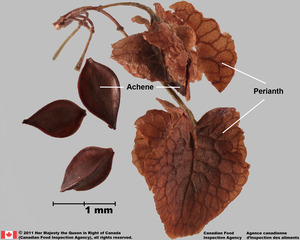 tube base persistent, style and stigmastigma:
tube base persistent, style and stigmastigma:
the portion of the pistil receptive to pollen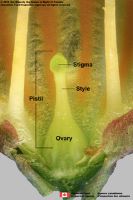 persistent at apexapex:
persistent at apexapex:
the point farthest from the point of attachment, or the "tip" of an organ of capsulecapsule:
of capsulecapsule:
a dry, dehiscent fruit derived from a compound ovary , with many seeds. Pericarppericarp:
, with many seeds. Pericarppericarp:
fruit wall or fruit coat
orange, yellow or white, thick, fleshy, roughenedroughened:
texture—having a small, stout, stiff, more or less acute protrusions
, ribbedribbed:
surface relief—wide, prominent, linear ridges that are generally rounded and longitudinally situated on the surface or papillatepapillate:
or papillatepapillate:
surface relief—bearing minute, distinct, broad-based projections, tapering to a rounded apex .
.
Seeds ellipsoidellipsoid:
3D shape—elliptic
, ovoidovoid:
3D shape—ovate , oblongoblong:
, oblongoblong:
2D shape—much longer than broad with nearly parallel sides, corners are rounded , 0.3–0.5 mm long, with long funiculifuniculus:
, 0.3–0.5 mm long, with long funiculifuniculus:
(alt. funicle) stalk connecting the ovule (later seed) to the ovary (later fruit) placenta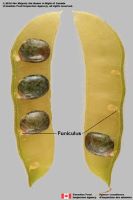 . Seed coat brown, loose, thin, reticulatereticulate:
. Seed coat brown, loose, thin, reticulatereticulate:
surface relief—netted, raised walls or concave grooves forming a net-like surface pattern with flat, concave, or convex interspaces or ribbedribbed:
or ribbedribbed:
surface relief—wide, prominent, linear ridges that are generally rounded and longitudinally situated on the surface .
.
Embryo miniature.
Endosperm absent.
| Fruit | |
| Type | capsulecapsule: a dry, dehiscent fruit derived from a compound ovary  |
| Size range | 1.5–6 mm long |
| Shape(s) | hemisphericalhemispherical: 2D shape—shaped like half a sphere , conicalconical: 3D shape—cone-shaped, with the point of attachment at the broad end  |
| Texture | fleshy |
| Surface relief | roughenedroughened: texture—having a small, stout, stiff, more or less acute protrusions , ribbedribbed: surface relief—wide, prominent, linear ridges that are generally rounded and longitudinally situated on the surface  , papillatepapillate: , papillatepapillate:surface relief—bearing minute, distinct, broad-based projections, tapering to a rounded apex  |
| Color(s) | orange, yellow or white |
| Unique features | Small, bright colored, fleshy, circumscissilecircumscissile: (~pyxis); type of capsular dehiscence, opens by a lid (splitting transversely)  capsulescapsule: capsulescapsule:a dry, dehiscent fruit derived from a compound ovary  each with a persistent perianthperianth: each with a persistent perianthperianth:collective term for calyx and corolla of a flower  and stylestyle: and stylestyle:in a flower, the narrow and elongated part of the pistil between the stigma and the ovary; sometimes persisting in fruit 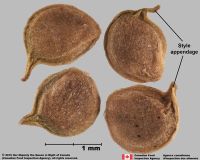 at the apexapex: at the apexapex:the point farthest from the point of attachment, or the "tip" of an organ  . . |
| Seed | |
| Size range | 0.3–0.5 mm long |
| Shape(s) | ellipsoidellipsoid: 3D shape—elliptic , ovoidovoid: 3D shape—ovate  , oblongoblong: , oblongoblong:2D shape—much longer than broad with nearly parallel sides, corners are rounded  |
| Surface relief | reticulatereticulate: surface relief—netted, raised walls or concave grooves forming a net-like surface pattern with flat, concave, or convex interspaces  , ribbedribbed: , ribbedribbed:surface relief—wide, prominent, linear ridges that are generally rounded and longitudinally situated on the surface  |
| Color(s) | brown |
| Unique features | Minute, brown seeds with loose, reticulatereticulate: surface relief—netted, raised walls or concave grooves forming a net-like surface pattern with flat, concave, or convex interspaces  or ribbedribbed: or ribbedribbed:surface relief—wide, prominent, linear ridges that are generally rounded and longitudinally situated on the surface  seed coats. seed coats. |
| Other | |
| Embryo | miniature |
| Nutritive tissue | endosperm absent |
Southeastern Asia, Africa, America, Australia, and New Zealand.
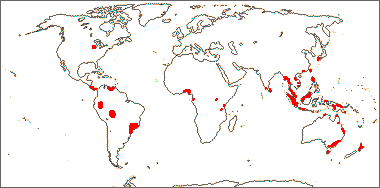
Distribution map courtesy of Angiosperm Phylogeny Website.
Baskin and Baskin 2021Baskin and Baskin 2021:
Baskin C and Baskin J. 2021. Relationship of the lateral embryo (in grasses) to other monocot embryos: A status up-grade. Seed Science Research 31 (3): 199-210. doi:10.1017/S0960258521000209; Cowley 1988Cowley 1988:
Cowley EJ. 1988. Burmanniaceae. In: Polhill RM, ed. Flora of Tropical East Africa. Vol 25. AA Balkema, Rotterdam Netherlands. 9 pp.; Dahlgren et al. 1985Dahlgren et al. 1985:
Dahlgren RMT, Clifford HT, and Yeo PF. 1985. The families of the monocotyledons: structure, evolution, and taxonomy. Springer-Verlag, Berlin. 520 pp.; Davidse et al. 2009–2018Davidse et al. 2009–2018:
Davidse GM, Sousa Sánchez M, Knapp S. and Chiang Cabrera F, eds. 2009–2018. Flora Mesoamericana. Missouri Botanical Garden, St. Louis, MO. Accessed: January–April 2024. URL: http://legacy.tropicos.org/Project/FM; Kirkbride et al. 2006Kirkbride et al. 2006:
Kirkbride JH, Jr, Gunn CR, and Dallwitz MJ. 2006. Family guide for fruits and seeds, vers. 1.0. Accessed September 2020-January 2022. URL: https://nt.ars-grin.gov/seedsfruits/keys/frsdfam/index.cfm .; Kubitzki et al. 1990+Kubitzki et al. 1990+:
Kubitzki K et al., eds. 1990+. The families and genera of vascular plants. 7+ vols. Berlin etc.; Nooteboom et al. 2021+Nooteboom et al. 2021+:
Nooteboom HP, de Wilde WJJO, Stevens PF, Coode MJE, and Saw LG. 2021+ Flora Malesiana Online. Accessed January 2021–March 2024. URL: https://portal.cybertaxonomy.org/flora-malesiana/; PlantNET 2021+PlantNET 2021+:
PlantNET (The NSW Plant Information Network System). 2021+. Royal Botanic Gardens and Domain Trust, Sydney. Accessed January 2021–March 2024. URL: https://plantnet.rbgsyd.nsw.gov.au; Stevenson and Loconte 1995Stevenson and Loconte 1995:
Stevenson DW and Loconte H. 1995. A cladistic analysis of monocot families. In: Rudall PJ, Cribb PJ, Cutler DF, and Humphries CJ, eds. Monocotyledons: Systematics and Evolution. Royal Botanic Gardens, Kew.; Takhtajan 2009Takhtajan 2009:
Takhtajan A. 2009. Flowering plants: Second edition. Springer Nature, Switzerland. 871 pp.; Watson and Dallwitz 1992+Watson and Dallwitz 1992+:
Watson L and Dallwitz MJ. 1992+. The families of flowering plants: descriptions, illustrations, identification, and information retrieval. Version: 6th Accessed September 2020-September 2022. URL: delta-intkey.com; Zhengyi et al. 2004+Zhengyi et al. 2004+:
Zhengyi W, Raven PH, and Deyuan H. 2004+. Flora of China [online]. 25 vols. Science Press, Beijing China & Missouri Botanical Garden, St. Louis USA. Accessed January–March 2024. http://flora.huh.harvard.edu/china/
*The number of genera and species is based on Christenhusz and Byng 2016Christenhusz and Byng 2016:
Christenhusz MJM and Byng JW. 2016. The number of known plant species in the world and its annual increase. Phytotaxa 261 (3): 201-217. https://doi.org/10.11646/phytotaxa.261.3.1, which may differ from the number of genera in GRIN-Global.